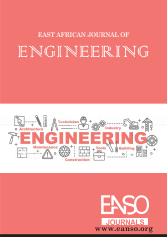Assessing the Level of Construction Mechanization in Kenya: A Survey of Highrise Building Projects in Nairobi
Abstract
This paper examines the construction mechanization level in high-rise building projects in Kenya. It focuses on Site Preparation and Earthworks (SPE), Scaffolding and Formwork (SF), Concreting (C), Walling (W), Plastering and Flooring (PF), Tiling and Painting (TP), and Building Services (BS). Mechanization, defined as the replacement of manual labour with machines, is analyzed through a quantitative survey involving 125 accredited construction site supervisors with the unit of analysis being the construction project. The findings reveal that SPE tasks predominantly utilize Hand Tools (43%) and Automated Hand Tools (41%), with Machines accounting for only 16%. Comparatively, SF tasks show slightly lower mechanization levels, primarily relying on Hand Tools (50%) and Automated Hand Tools (41%). Concreting is the most mechanized work category with most of the tasks primarily executed using Automated Hand Tools (67%) and Machine/Workstation (26%). Walling tasks mainly rely on Hand Tools (54%) and Automated Hand Tools (33%). PF, TP, and BS tasks predominantly rely on Hand Tools (70%, 77%, and 68% respectively). Consequently, more than half (53%) of the activities in the building construction sector in Kenya are carried out using Hand Tools. This is then followed by Automated Hand Tools with an approximate usage of 31%. Completely Manual methods and Machines (workstations) are used almost similarly at 9% and 7% respectively. None of the activities in construction are Completely Automated (robotized). The mechanization levels for the various work categories are as follows; SPE=52%, SF=47%, C=64%, W=48%, PF=41%, TP=38%, and BS=39%. The overall mechanization level for the construction industry of Kenya was found to be 47%, indicating a substantial reliance on manual methods. Despite the advantages of mechanization, such as improved efficiency and safety, its application in Kenyan construction remains limited. The study highlights the need for increased mechanization to enhance productivity and safety in construction practices
Downloads
References
Bartlett, J. E., Kotrlik, J. W., & Higgins, C. C. (2001). Organizational Research: Determining Appropriate Sample Size in Survey Research. Information Technology, Learning, and Performance Journal, 19(1), 43–50.
Brosnan, L. (2023). Heavy Equipment Site Preparation for Construction. Retrived from: https://conplant.com.au/news/heavy-equipment-site-preparation-for-construction/. Accessed on August 30, 2024.
Calvetti, D., Mêda, P., Gonçalves, M. C., & Sousa, H. (2021). Mechanization of Construction Tasks: Level Assessment and Craft Workforce Awareness. Proceedings of the European Conference on Computing in Construction, July, 342–349. https://doi.org/10.35490/EC3.2021.172
Cochran, W. G. (1977). Sampling techniques (3rd ed.). John Wiley & Sons. New York.
Food and Agriculture Organization. (2024). Preparation of the Construction Site. Retrived from: https://www.fao.org/fishery/docs/CDrom/FAO_Training/FAO_Training/General/x6708e/x6708e05.htm#top. Accessed on August 30, 2024
Grover, P., & Solanki, S. K. (2023). Effects of Mechanization on Resource Productivity. Journal of Engineering Analysis and Design, 5(1), 1–17.
Hwang, B. G., Shan, M., Ong, J. J. M., & Krishnankutty, P. (2020). Mechanization in building construction projects: assessment and views from the practitioners. Production Planning and Control, 31(8), 613–628. https://doi.org/10.1080/09537287.2019.1667547
Idoro, G. I. (2011). Effect of mechanisation on occupational health and safety performance in the Nigerian construction industry. Journal of Construction in Developing Countries, 16(2), 27–45.
Iheama, N. B., Alinta-Abel, U., & Ezeokoli, O. (2017). Evaluation of mechanization in building production as a way of cost reduction: A study of some construction sites in Enugu South local Government area. British Journal of Environmental Sciences, 5(2), 14–30.
Jessica. (2021). How Does A Plastering Machine Work? Retrieved from: https://blog.ces-hire.com/how-does-a-plastering-machine-work#:~:text=A spray plaster machine uses,projection in the spray gun. Accessed on September 1, 2024.
Kamaruddin, S. S., Mohammad, M. F., & Mahbub, R. (2016). Barriers and Impact of Mechanisation and Automation in Construction to Achieve Better Quality Products. Procedia - Social and Behavioral Sciences, 222(1), 111–120. https://doi.org/10.1016/j.sbspro.2016.05.197
Kamaruddin, S. S., Mohammad, M. F., Mahbub, R., & Ahmad, K. (2018). The Mechanisation and Automation of the IBS Construction Approach in Malaysia. Asian Journal of Environment-Behaviour Studies, 3(10), 167–177. https://doi.org/10.21834/aje-bs.v3i10.324
Sekaran, U. (2003). Research Methods for Business: A Skill Building Approach (2nd ed.). John Wiley & Sons, Inc. New York.
Sharmila, S., Devadoss, R. S., & Mathew, F. (2018). Impact of mechanisation in construction projects in India. International Journal of Civil Engineering and Technology, 9(13), 1998–2008.
Vadukkumchery, A. S., & Myneni, K. K. (2023). Assessment of Impact of Mechanization in Construction Projects in India. Indian Journal Of Science And Technology, 16(10), 727–743. https://doi.org/10.17485/ijst/v16i10.1467
Vishwakarma, K., Sushil, ;, & Solanki, K. (2022). Mechanization and Automation in Construction. International Journal of Advances in Engineering and Management (IJAEM), 4(5), 2395–5252. https://doi.org/10.35629/5252-04053856
Copyright (c) 2024 Dennis Mumo Ndolo, Stephen Diang’a, PhD, Oswald Gwaya, PhD

This work is licensed under a Creative Commons Attribution 4.0 International License.




























